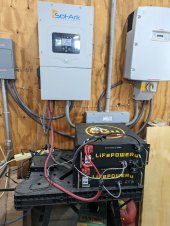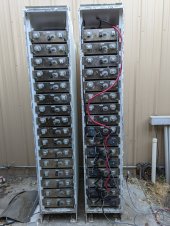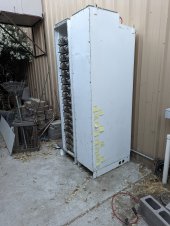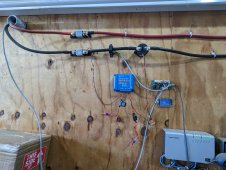I hear ya'll but what happens when the BMS fails? What happens if the fire department doesn't show up? Life is full of risk. Show me an example of someone burning down their house with a Tesla battery and I'll show you someone who still doesn't care. Just because Will is afraid of LiPo's doesn't mean we all have to be.
Thanks for the info and your DIY powerwall posts.
I won’t get into the weeds on Tesla battery fires, but I show the princess fire often to my clients.
I ended up with 32 Tesla “model S” type batteries in steel cases put together by Princeton Battery (GTIB30’s). They had set at 2.2V for a couple of years and I brought them back slowly and carefully over a 60 day period with a combination of a small variable voltage and current battery charger and (10 amps max mostly around 4 amps) and then SHORT high current charges from a Victron Blue Smart 24/12 (I could dial the voltage down). I also carefully noted the temps and voltages but did it without a BMS.
NOTE: I WOULD NOT DO IT AGAIN WITHOUT A BMS
I got 8 of them working reasonably well and then put together a SIMP BMS configuration and started experimenting and monitoring.
My old SMA 8KW from 2008 died so installed a DEYE (Sol-Ark 12K) and a Discover 42-48-6650, it worked well and tested both the SOK and the EG4 48V batteries for TOU arbitrage.
Put 8 of the Tesla’s in a steel case outside my home metal shop and hand-built the molex connectors and the wiring harness for the SIMP BMS to interface with the existing Tesla balancing boards. (this was the hardest part for I am not young, and my vision is not what it used to be.)
The Simp BMS is not plug and play, not intuitive, and not for anyone who gets frustrated at failure. It a pain and requires networking understanding, RS485 knowledge, firmware upgrade and serial interface experience. It works one way on Termite for configuration and needs something like Secure CRT for monitoring and logging. I have not figured out how to use Secure CRT on it for configuration purposes, and I have 30 yrs of experience in serial interface programs.
I did install a current CT and a CONTACTOR failsafe (requires power to charge or discharge the battery) The contactor works perfectly and is easily configurable for fail-safe, and the CT is unreliable in my opinion, but I have other ways to monitor the current.
I experimented with charge and discharge voltages, it worked well for a few weeks and then I put in another 8 batteries and implemented TOU arbitrage and moved on to other projects.
A few months went by and I checked it a few times a week and noticed Module 09 cell 52 was creeping close to 4.12v and we had a 200mv delta in the 96 cells (0-95)
It disconnected at 4.12 and I played around with voltages (dropping the charging voltage) but it still disconnected. I had to go in and modify the balancing voltage down to a point we could get active balancing enough hours a day to drop the delta down below 160mv.
I have a bad cell and will pull it out of the pack before the summer when the charge and discharge accelerates the delta and my self-imposed pack disconnect. I suspect there will more bad ones show up as I add the 2nd 16 batteries.
Module #8 23.58V Cell42: 3.93V Cell43: 3.93V Cell44: 3.93V Cell45: 3.93V Cell46: 3.93V Cell47: 3.93V Neg Term Temp: 15.86C Pos Term Temp: 15.10C
Module #9 23.72V Cell48: 3.98V Cell49: 3.89V Cell50: 3.97V Cell51: 3.89V Cell52: 4.11V Cell53: 3.89V Neg Term Temp: 15.95C Pos Term Temp: 15.16C
Module #10 23.40V Cell54: 3.91V Cell55: 3.90V Cell56: 3.90V Cell57: 3.90V Cell58: 3.90V Cell59: 3.90V Neg Term Temp: 15.67C Pos Term Temp: 14.82C
Modules: 16 Cells: 96 Strings: 8 Voltage: 47.122V Avg Cell Voltage: 3.927V Low Cell Voltage: 3.886V High Cell Voltage: 4.111V Delta Voltage: 225mV Avg Temp: 15.792C
The bottom line is the fail-safe contactor is REALLY important and a cell can go bad in the middle of the pack. Probably why the units failed.
This was all done in 2021 and 2022, and sorry I did not have the time to document it, but life gets busy (GRIN) that is a good thing.
Currently, my Sol-Ark charge voltages are 46V and battery empty is 41V







